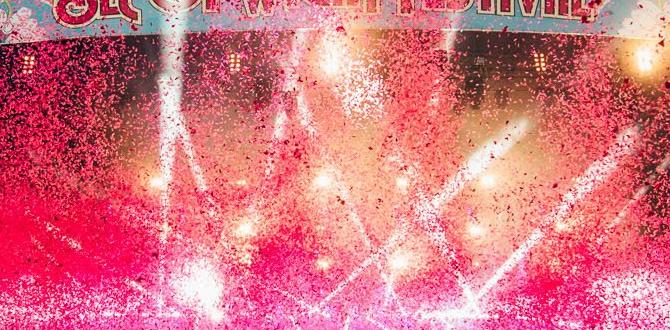Imagine dancing in the streets, surrounded by colorful costumes and joyful music. This is what festivals in the Philippines are like! Each year, these special events bring everyone together in a lively celebration. Have you ever wondered what makes these festivals so unique?
From the vibrant Ati-Atihan to the spectacular Sinulog, every celebration tells a story. Festivals in the Philippines are rooted in rich traditions and local culture. They show how diverse and beautiful the country is. What a wonderful way to learn about different places!
Did you know that some festivals last for days? Families often join in the fun, creating memories that last a lifetime. These exciting gatherings are perfect for tasting delicious food, making new friends, and enjoying amazing performances. Festivals in the Philippines offer more than just entertainment; they provide a glimpse into Filipino life and history.
As we explore these colorful events, get ready to discover the magic and wonder that waits at every turn!
Festivals In The Philippines: Celebrating Culture And Tradition

Festivals in the Philippines
The Philippines is a vibrant country known for its lively festivals. Each year, locals celebrate their rich culture and traditions. Colorful parades, lively music, and delicious food fill the streets. Did you know that the Sinulog Festival attracts thousands of visitors every January? It honors the Santo Niño and showcases stunning dance performances. Festivals like Ati-Atihan and Pahiyas also highlight unique customs. Exploring these events offers a fantastic way to experience Filipino hospitality and joy!1. Historical Background of Philippine Festivals
Evolution of festivals in the Philippines. Influence of colonial history on local traditions.The evolution of festivals in the Philippines is like a thrilling roller coaster ride! It all started when ancient tribes celebrated good harvests and honored their gods. When colonizers arrived, they added their own twist! Local traditions mixed with foreign influence. This blend created colorful fiestas that are deeply rooted in the country’s colonial history. Now, Philippine festivals share stories of both the past and the present, resembling a colorful scrapbook filled with memories and fun!
| Era | Festival Features |
|---|---|
| Pre-Colonial | Rituals celebrating nature and deities |
| Spanish Era | Introduction of religious and cultural themes |
| Modern Times | Diverse styles blending old traditions with new |
In short, these festivals are like a party where everyone is invited, and the only rules are to have fun and enjoy delicious food!
3. Religious Festivals
Significance of religious festivals in Filipino culture. Notable religious festivals (e.g., Sinulog, AtiAtihan).Religious festivals in the Philippines play a big part in Filipino culture. People gather to celebrate faith, community, and tradition. Two famous ones are Sinulog and AtiAtihan. Sinulog is a colorful dance festival in Cebu, honoring the Santo Niño, and it happens every January. Meanwhile, AtiAtihan celebrates the feast of the Santo Niño in Kalibo. Both festivals are full of music, dancing, and yummy food. These events show the heart of Filipino beliefs and bring everyone closer together.
| Festival | Location | Significance |
|---|---|---|
| Sinulog | Cebu | In honor of Santo Niño |
| AtiAtihan | Kalibo | Celebration of Santo Niño |
4. Cultural Festivals
Celebration of indigenous art, music, and dance. Examples of prominent cultural festivals (e.g., Pahiyas, Panagbenga).The Philippines is full of vibrant cultural festivals that celebrate indigenous art, music, and dance. One big event is Pahiyas, held in Lucban, Quezon, where locals showcase colorful rice designs that make your eyes dance! Another popular festival is Panagbenga in Baguio, which features beautiful flower floats and lively street dancing. Below is a quick table to help you remember some exciting details about these festivals:
| Festival | Location | Highlights |
|---|---|---|
| Pahiyas | Lucban, Quezon | Colorful rice designs |
| Panagbenga | Baguio | Flower floats and street dance |
These festivals are not only fun but also a wonderful way to appreciate Filipino culture. So, if you find yourself there, don’t forget to join the celebration!
5. Festivals Celebrated Throughout the Year
Calendar of major festivals and their dates. Description of activities and events for each festival.Throughout the year, the Philippines buzzes with lively festivals. Here are five major festivals you don’t want to miss:
- Sinulog Festival (January): This celebration honors the Santo Niño. You can see colorful parades and dance contests.
- Pahiyas Festival (May): People decorate their homes with rice and colorful fruits. It’s a feast for the eyes!
- Kadayawan Festival (August): This festival is all about nature and culture. Enjoy street dancing and a grand flower float parade.
- Ati-Atihan Festival (January): Participants paint their faces and wear tribal costumes. It’s a loud and joyful event!
- Panagbenga Festival (February): This flower festival features stunning floats and street dancing, celebrating the beauty of Baguio City.
These festivals are a window into the rich culture of the Philippines. Each event shines with lively colors, music, and joy!
6. Unique Practices and Traditions During Festivals
Common customs and traditions observed during festivals. The role of food, music, and dance in celebrations.Festivals in the Philippines are colorful and lively. People celebrate with special customs that connect everyone. Food plays a big role. Families cook delicious meals to share. Popular dishes like lechon and lumpia are must-haves. Music and dance bring joy to these events. Traditional songs fill the air, while lively dances showcase culture. These activities make the festivals exciting and memorable, with everyone joining in the fun!
What customs are celebrated during festivals?
Common customs include sharing food, wearing colorful costumes, and participating in lively dances. These traditions create a sense of community and joy among the people.
Key Elements of Festivals:
- Food: Traditional dishes enjoyed by everyone.
- Music: Performances that celebrate culture and history.
- Dance: Energetic movements that tell stories and bring people together.
7. Impact of Festivals on Local Communities
Economic benefits of festivals to local businesses. Role of festivals in community bonding and cultural preservation.Festivals breathe life into local communities, like a splash of color on a dull canvas. They help businesses bloom with visitors eager to buy tasty treats and unique crafts. Want to know a secret? Festivals can boost sales by over 30%! But that’s not all. These joyful gatherings spark joy and camaraderie among neighbors. People bond over laughter, dancing, and delicious food, while also keeping their culture alive. So remember, festivals are not just parties—they’re valuable community glue!
| Benefits | Details |
|---|---|
| Economic Growth | Local shops see a sales spike during festivals. |
| Community Bonding | Neighbors unite through shared celebrations. |
| Cultural Preservation | Festivals keep traditions alive for future generations. |
8. Tips for Visitors Attending Festivals
Best practices for experiencing festivals as a tourist. Essential items to bring and local etiquette to observe.Going to a festival is exciting! To enjoy every moment, here are some tips. First, always bring cash for food and games. Next, wear comfy shoes for walking. It’s also smart to stay hydrated, so carry water. Remember to respect local customs. Ask before taking photos of people. Here are other good practices:
- Arrive early for the best spots.
- Try local foods; they tell a story.
- Learn a few words in the local language.
- Be polite and greet others with a smile.
Following these tips makes the festival fun and memorable!
What should I wear to a festival?
Wearing comfortable clothes helps you enjoy the day. Choose light fabrics for hot weather. Don’t forget sturdy shoes!
9. Future of Festivals in the Philippines
Adapting festivals in the face of modernization and globalization. Potential changes in festival traditions over time.Festivals in the Philippines will change as the world evolves. Modernization and globalization affect how people celebrate. Technology allows people to connect through festivals online. Some traditions may fade, while new ones emerge. With more visitors, local foods and cultures can shine brighter than ever. Getting creative is key; festivals may blend old and new ideas for fun!
How can festivals adapt to modern times?
Festivals can use social media and online platforms to promote events and reach wider audiences. Traditional cooking methods can mix with new tastes, attracting young festival-goers while keeping the essence of the old.
Potential changes in festival traditions:
- Greater emphasis on digital experiences.
- More international influences in music and art.
- Innovative ways to showcase local culture.
Conclusion
Festivals in the Philippines are colorful and lively celebrations of culture and tradition. They showcase joy, music, and dance. Each festival is unique, reflecting different local stories and customs. You can join in the fun by visiting during these events. Explore more about these amazing festivals in books or online to see which one interests you the most!FAQs
What Are Some Of The Most Popular Festivals Celebrated In The Philippines, And What Do They Commemorate?Some popular festivals in the Philippines include Sinulog, Ati-Atihan, and Pahiyas. The Sinulog festival honors the Santo Niño, or Child Jesus. Ati-Atihan celebrates the feast of Santo Niño and shows gratitude for blessings. Pahiyas is a harvest festival where we decorate homes with rice and colorful leaves to thank for a good crop. Each festival is fun with lively music, dancing, and colorful costumes!
How Do Local Communities Prepare For And Participate In Festivals Such As Sinulog And Ati-Atihan?Local communities prepare for festivals like Sinulog and Ati-Atihan by decorating their streets. Everyone gathers to create colorful decorations and costumes. We practice dance moves and songs to perform during the festival. On festival day, people join parades, sing, and dance together to celebrate. It’s a fun time for everyone to enjoy and share traditions!
What Role Do Traditional Music And Dance Play In The Celebrations Of Philippine Festivals?Traditional music and dance are very important in Philippine festivals. They help show our culture and history. When we celebrate, we sing and dance together. This makes everyone feel happy and connected. It’s a fun way to enjoy special moments with family and friends.
How Do Festivals In The Philippines Differ Between Regions, And What Unique Customs Are Associated With Each?Festivals in the Philippines are very different depending on where you are. In Cebu, people celebrate Sinulog with colorful parades and dancing. In Pampanga, they have the Giant Lantern Festival with huge, bright lanterns. Meanwhile, in Aklan, Ati-Atihan features people painting their faces and dancing to drums. Each festival shows the unique culture and traditions of its region.
In What Ways Do Festivals Contribute To Tourism And The Economy In The Philippines?Festivals in the Philippines bring many visitors. When tourists come, they spend money on food, clothes, and fun activities. This helps local businesses grow. Plus, festivals create jobs for people in the area. They make our culture famous and can attract even more visitors in the future!







